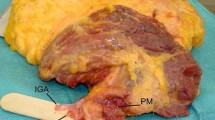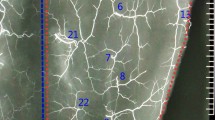Abstract.
Flap surgery in the distal part of the gluteal region has to deal with a lack of detailed descriptions of the inferior gluteal artery and the posterior femoral cutaneous nerve. The existing papers are mainly clinical studies, based on low numbers of observations. Our study includes 118 cadaveric gluteal regions. The descending branch was present in 91% and gave rise to a cutaneous branch. When the descending branch was absent, this cutaneous branch came from the medial or lateral femoral circumflex artery or as a perforator of the deep artery of the thigh. The posterior femoral cutaneous nerve was found in a common sheath of connective tissue with the descending branch of the inferior gluteal artery in 72% of cases. Nerve loops around the vessel are present in 29%. Our results show that a cutaneous or fasciocutaneous flap, either local or free, in this region can be reliably lifted on a cutaneous branch of the descending branch of the inferior gluteal artery without loss of sensitivity. However, the close relationship of the artery and nerve limits the arc of rotation in the case of a local flap. The French version of this article is available in the form of electronic supplementary material and can be obtained by using the Springer Link server located at http://dx.doi.org/10.1007/s00276-002-0064-z.
Résumé.
La chirurgie des lambeaux dans la partie distale de la région glutéale se heurte à un manque de description détaillée de l'artère glutéale inférieure et du nerf cutané postérieur de la cuisse. Les articles déjà publiés sont essentiellement des études cliniques, basées sur un faible nombre d'observations. Notre travail s'appuie sur 118 régions glutéales de cadavres. Le rameau descendant était présente dans 91% des cas et donnait naissance à une branche cutanée. En son absence, cette branche cutanée naissait de l'artère circonflexe fémorale médiale ou latérale, ou sous forme d'une artère perforante issue de l'artère profonde de la cuisse. Le nerf cutané postérieur de la cuisse se trouvait dans une gaine conjonctive commune avec le rameau descendant de l'artère glutéale inférieure dans 72% des cas. Une boucle nerveuse entourant le vaisseau était présente dans 29% des cas. Nos résultats montrent qu'un lambeau cutané ou fascio-cutané, pédiculé ou libre, prélevé dans cette région peut être levé en toute sécurité sur une branche cutanée du rameau descendant de l'artère glutéale inférieure sans perte de sensibilité. Cependant les rapports étroits de l'artère et du nerf limitent l'arc de rotation en cas de lambeau pédiculé.
Similar content being viewed by others
Author information
Authors and Affiliations
Additional information
Electronic Publication
Rights and permissions
About this article
Cite this article
Windhofer, .C., Brenner, .E., Moriggl, .B. et al. Relationship between the descending branch of the inferior gluteal artery and the posterior femoral cutaneous nerve applicable to flap surgery. Surg Radiol Anat 24, 253–257 (2002). https://doi.org/10.1007/s00276-002-0064-z
Received:
Accepted:
Issue Date:
DOI: https://doi.org/10.1007/s00276-002-0064-z




